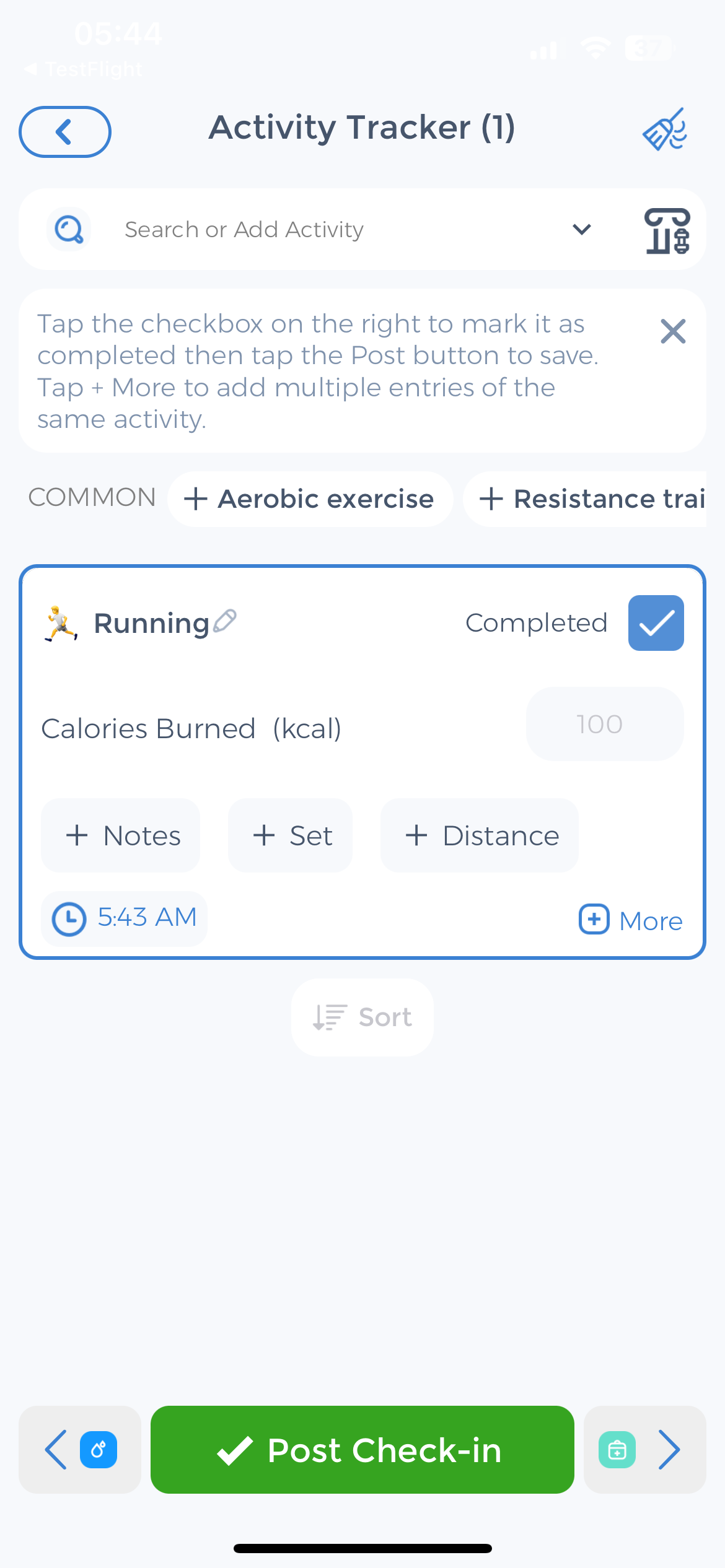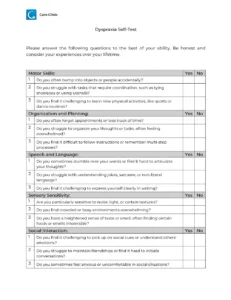
Dyspraxia, also known as Developmental Coordination Disorder (DCD), is a neurodevelopmental disorder that affects an individual’s ability to plan and coordinate movements. It can impact various areas of life, including fine and gross motor skills, coordination, and organization. If you suspect that you or someone you know may have dyspraxia, it is important to understand the condition, identify its signs and symptoms, undergo a comprehensive dyspraxia test, and explore management strategies to improve daily functioning.[1][2]
Printable Dyspraxia Test
⬇️ Dyspraxia Test PDF Printable[3][4]
Understanding Dyspraxia: An Overview
Dyspraxia is often misunderstood and misdiagnosed. It is crucial to gain a comprehensive understanding of dyspraxia to recognize its impact and seek appropriate support. Dyspraxia is not simply clumsiness or laziness, but rather a neurological condition that affects the brain’s ability to plan, execute, and coordinate movements. It can manifest differently in children and adults, and its effects can vary from individual to individual.
Let’s delve deeper into the world of dyspraxia and explore the intricacies of this condition. Dyspraxia, also known as Developmental Coordination Disorder (DCD), is a lifelong condition that affects around 5-10% of the population. It is more common in boys than girls, and its exact cause is still not fully understood. However, researchers believe that a combination of genetic and environmental factors may contribute to its development.
Defining Dyspraxia: What It Is and Isn’t
Before delving into the specifics of dyspraxia, it is important to clarify what the condition is and what it is not. Dyspraxia is not related to intelligence, and individuals with dyspraxia can have average or above-average cognitive abilities. It is not a result of muscle weakness but rather a difficulty in transmitting messages from the brain to the body. Understanding these distinctions is essential in debunking misconceptions and providing accurate information about dyspraxia.
Individuals with dyspraxia often face challenges in various areas of their lives. Fine motor skills, such as tying shoelaces or buttoning a shirt, can be particularly difficult. Additionally, gross motor skills, like riding a bike or catching a ball, may require extra effort and practice. These difficulties can sometimes lead to frustration and feelings of inadequacy, but it is important to remember that dyspraxia does not define a person’s worth or potential.
The Impact of Dyspraxia on Daily Life
 Dyspraxia can affect various aspects of daily life, including self-care tasks, academic performance, social interactions, and emotional well-being. Difficulties with coordination and planning can make activities such as dressing, eating, and grooming challenging. In a special educational settings, dyspraxia may impact handwriting, organization, and participation in physical education classes. Socially, individuals with dyspraxia may struggle with fine motor skills, sports activities, and navigating unfamiliar environments. Understanding the impact of dyspraxia on various aspects of life is essential in providing appropriate support and accommodations.
Dyspraxia can affect various aspects of daily life, including self-care tasks, academic performance, social interactions, and emotional well-being. Difficulties with coordination and planning can make activities such as dressing, eating, and grooming challenging. In a special educational settings, dyspraxia may impact handwriting, organization, and participation in physical education classes. Socially, individuals with dyspraxia may struggle with fine motor skills, sports activities, and navigating unfamiliar environments. Understanding the impact of dyspraxia on various aspects of life is essential in providing appropriate support and accommodations.
It is important to note that dyspraxia is a lifelong condition, and individuals with dyspraxia may face unique challenges as they transition into adulthood. The demands of higher education, employment, and independent living can present additional hurdles. However, with the right support, individuals with dyspraxia can thrive and achieve their goals.
Dyspraxia is a complex condition that goes beyond mere clumsiness. It affect individuals in various ways and can have a significant impact on their daily lives. By understanding dyspraxia and its effects, we can create a more inclusive and supportive society for those with this condition.[5]
 Dyspraxia can affect various aspects of daily life, including self-care tasks, academic performance, social interactions, and emotional well-being. Difficulties with coordination and planning can make activities such as dressing, eating, and grooming challenging. In a special educational settings, dyspraxia may impact handwriting, organization, and participation in physical education classes. Socially, individuals with dyspraxia may struggle with fine motor skills, sports activities, and navigating unfamiliar environments. Understanding the impact of dyspraxia on various aspects of life is essential in providing appropriate support and accommodations.
Dyspraxia can affect various aspects of daily life, including self-care tasks, academic performance, social interactions, and emotional well-being. Difficulties with coordination and planning can make activities such as dressing, eating, and grooming challenging. In a special educational settings, dyspraxia may impact handwriting, organization, and participation in physical education classes. Socially, individuals with dyspraxia may struggle with fine motor skills, sports activities, and navigating unfamiliar environments. Understanding the impact of dyspraxia on various aspects of life is essential in providing appropriate support and accommodations.
It is important to note that dyspraxia is a lifelong condition, and individuals with dyspraxia may face unique challenges as they transition into adulthood. The demands of higher education, employment, and independent living can present additional hurdles. However, with the right support, individuals with dyspraxia can thrive and achieve their goals.
Dyspraxia is a complex condition that goes beyond mere clumsiness. It affect individuals in various ways and can have a significant impact on their daily lives. By understanding dyspraxia and its effects, we can create a more inclusive and supportive society for those with this condition.
Identifying Dyspraxia: Signs and Symptoms
Identifying dyspraxia is the first step towards accessing the necessary support and interventions. Early recognition and diagnosis can significantly improve outcomes for individuals with dyspraxia. It is important to be aware of the common signs and symptoms of dyspraxia in children and adults.
Common Symptoms in Children
In children, dyspraxia may present as delayed milestones, difficulty with fine motor tasks (such as tying shoelaces or using utensils), poor handwriting, trouble with balance and coordination, and challenges in planning and organizing. Additionally, child’s symptoms may exhibit sensory processing difficulties, such as sensitivity to touch or sound. If you notice these symptoms in your child, it is advisable to seek a comprehensive evaluation from a healthcare professional.
Recognizing Dyspraxia in Adults
Dyspraxia can continue to impact individuals into adulthood, although symptoms may manifest differently compared to childhood. Adults with dyspraxia may face difficulty learning activities such as driving, organizing schedules, maintaining everyday tasks, and participating in sports or physical activities. Difficulties with coordination and planning may also affect daily tasks, such as cooking or using tools. If you suspect that you or someone you know may have dyspraxia, consulting with an occupational therapist is a valuable step towards obtaining an accurate diagnosis.
It is important to note that dyspraxia is a complex condition that can have a wide range of effects on individuals. While the symptoms mentioned above are common, it is possible for individuals with dyspraxia to experience additional challenges that are not listed. For example, some children with dyspraxia may struggle with social situations and interactions or have difficulty with speech and language development.
Furthermore, the impact of dyspraxia can vary from person to person. While some individuals may experience mild difficulties that can be managed with targeted interventions, others may face more significant challenges that require ongoing support. It is crucial to approach each individual’s experience with dyspraxia with empathy and understanding, recognizing that their needs may be unique.
The Dyspraxia Test: A Comprehensive Guide
Undergoing a dyspraxia test is crucial in formalizing a diagnosis and understanding the specific challenges associated with dyspraxia. While dyspraxia cannot be diagnosed through a single test, healthcare professionals use a comprehensive approach to assess an individual’s motor skills and motor disorder, coordination, and other relevant areas.
Individuals seeking a dyspraxia test often experience a range of symptoms that impact their daily lives. These can include difficulties with coordination, balance, fine motor skills, organization, planning, and sensory processing. By undergoing a thorough assessment, individuals can gain a better understanding of their strengths and areas that may require additional support.
Preparing for the Test
Prior to the test, it is important to gather relevant information about the individual or child’s medical history and treatment, developmental milestones, and any observed difficulties. This will provide valuable insights for the healthcare professional conducting the assessment. It may be helpful to keep a diary or checklist of observed challenges in different areas of life to share during the evaluation.
Furthermore, preparing mentally for the test is essential. Individuals may feel anxious or uncertain about the assessment process, and it is important to address any concerns or questions they may have. Creating a supportive environment and discussing the purpose of the test can help alleviate some of the stress associated with the evaluation.
What to Expect During the Test
A dyspraxia test typically involves a series of assessments to measure fine and gross motor skills, coordination, sensory processing, and other relevant areas. The healthcare professional may observe the individual performing various tasks, ask questions about daily functioning, and potentially administer standardized assessments. The specific components of the test may vary depending on the healthcare professional and the individual’s age.
During the assessment, individuals may be asked to perform tasks such as drawing shapes, catching a ball, navigating obstacle courses, or imitating movements. These activities help evaluate different aspects of motor coordination and skill development. Additionally, the healthcare professional may inquire about the individual’s experiences in academic, social, and recreational settings to gain a comprehensive understanding of how dyspraxia impacts various aspects of their life.
Interpreting the Results: What They Mean
Once the dyspraxia test is complete, the healthcare professional will interpret the results and provide a diagnosis if appropriate. Understanding the results is essential in gaining insights into the specific challenges associated with dyspraxia and developing tailored strategies for managing symptoms.
Understanding Your Dyspraxia Score
The healthcare professional will explain the test results, including areas of strength and weakness. This information will help identify the specific motor and coordination difficulties associated with dyspraxia. It is important to ask questions and seek clarification to fully comprehend the implications of the test results.
Next Steps After Diagnosis
Following a dyspraxia diagnosis, it is crucial to explore appropriate interventions and support systems. This may involve collaborating with healthcare professionals, educators, and therapists to develop an individualized management plan. Occupational therapy, speech therapy, and physical therapy may be recommended to address specific areas of difficulty. Additionally, implementing strategies to support executive functioning, organization, and sensory processing can help individuals with dyspraxia thrive in daily life.
Managing Dyspraxia: Strategies and Techniques
While dyspraxia cannot be cured, individuals can develop effective strategies and techniques to manage their symptoms and improve overall functioning. Implementing various interventions and adjustments can significantly enhance quality of life for individuals with dyspraxia.
Therapies and Interventions for Dyspraxia
Occupational therapy (OT), speech therapy, and physical therapy are key interventions for individuals with dyspraxia. OT focuses on developing fine motor skills, coordination, and sensory processing. Speech therapy addresses communication challenges, including articulation and language skills. Physical therapy helps improve gross motor skills, strength, and balance. These therapies can be highly beneficial in addressing specific areas of difficulty and promoting overall development.
Coping Mechanisms and Lifestyle Adjustments
 Aside from therapy, there are various coping mechanisms and lifestyle adjustments that individuals with dyspraxia can incorporate into their daily routines. Breaking down tasks into smaller steps, utilizing visual aids and checklists, developing routines and schedules, and utilizing assistive technologies can all be highly effective in managing dyspraxia symptoms. Additionally, engaging in regular physical activity, practicing stress management techniques, and seeking social support can contribute to overall well-being.
Aside from therapy, there are various coping mechanisms and lifestyle adjustments that individuals with dyspraxia can incorporate into their daily routines. Breaking down tasks into smaller steps, utilizing visual aids and checklists, developing routines and schedules, and utilizing assistive technologies can all be highly effective in managing dyspraxia symptoms. Additionally, engaging in regular physical activity, practicing stress management techniques, and seeking social support can contribute to overall well-being.
Identifying and managing dyspraxia is a multifaceted process that requires understanding the condition, recognizing its signs and symptoms, undergoing comprehensive testing, and implementing appropriate management strategies. By taking proactive steps and seeking the necessary support, individuals with dyspraxia can navigate daily challenges more effectively and lead fulfilling lives. Remember, a dyspraxia diagnosis does not define you or your capabilities but rather equips you with the knowledge and resources to thrive.
Use the CareClinic App to Monitor a Child’s Mental Ability and Fine Motor Skills
Take control of your dyspraxia management with the CareClinic App, a comprehensive health tracker designed to support individuals with coordination and planning challenges. By utilizing the app’s features to track daily activities, symptoms, and therapy progress, you can gain valuable insights into your condition. The CareClinic App allows you to set reminders for medication and treatment, appointments, and exercises, ensuring consistency in your management plan. With this personalized approach, the app helps you stay organized and on top of your health goals.
Download the CareClinic App and Manage Developmental Coordination Disorder
Experience the benefits of the CareClinic App by monitoring the effectiveness of various therapies and interventions for dyspraxia. The app’s reporting feature provides a clear overview of your progress over time, helping you and your healthcare providers make informed decisions about your care. By regularly tracking your journey with dyspraxia, the CareClinic App empowers you to identify patterns and make adjustments for improved health outcomes. Take the next step in your dyspraxia management journey and Install App today.
References
- “Developmental Coordination Disorder (Dyspraxia) – StatPearls – NCBI Bookshelf”. https://www.ncbi.nlm.nih.gov/books/NBK603724/
- “Developmental Coordination Disorder | Psychology Today”. https://www.psychologytoday.com/us/conditions/developmental-coordination-disorder
- “Dyspraxia Checklist | Inclusion | Twinkl (Teacher-Made)”. https://www.twinkl.com/resource/dyspraxia-initial-screening-checklist-t-s-2548608
- “Dyspraxia Symptom Test for Children – ADDitude”. https://www.additudemag.com/quiz/dyspraxia-symptom-test-for-children/
- “Dyspraxia: What It Is, Causes, Symptoms, Diagnosis & Treatment”. https://my.clevelandclinic.org/health/diseases/23963-dyspraxia-developmental-coordination-disorder-dcd
- “Dyspraxia Foundation”. https://dyspraxiafoundation.org.uk/children-and-families/dyspraxia-in-children
- “Symptoms | Dyspraxia Foundation”. https://www.dyspraxia.com.hk/symptoms
- “dyspraxia & adults – Dyspraxia Foundation USA”. https://dyspraxiausa.org/dyspraxia-and-adults/
- “Dyspraxia Foundation”. https://dyspraxiafoundation.org.uk/adults/dyspraxia-in-adults
- “Dyspraxia in Adults: Symptoms & Support – Acibadem Health Point – ACIBADEM Hospitals – Acibadem Health Group”. https://www.acibademhealthpoint.com/dyspraxia-in-adults-symptoms-support/



